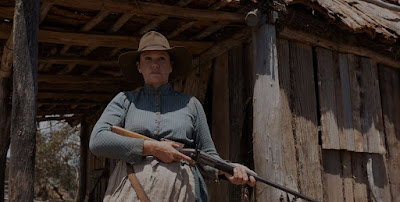Ok, cheap shots aside, there wouldn't seem to be much to say about this one. It hits its marks and says its lines exactly as expected, never straying too far into the darker realm of its promise so as to alienate its core audience (i.e. anyone who buys a ticket). The Grabber's menace, even though he has clearly killed his other victims, feels less serious than the malevolence of the bullies at school and he leaves Finney alone in the basement with plenty of light and time to think and chat with the ones who call him on the phone (that's in the trailer). Even the ploy (which I won't spoil) by which The Grabber teases Finney (and had done to the others) allows for a lot of leeway. The difference between what we increasingly learn of the victims' fate and Finney's relative ease is never quite squeezed into tension.
The '70s setting is pleasantly evoked with a kind of moody under-stopped daylight and a far more muted approach to the hair and clothes styles of the day. This continues into Gwen's dreamscapes which frequently look like real life. Only one sourced period pop song blares out and its appearance is appropriate. Later an extract of a sequence from Dark Side of the Moon pops up but is again functional. This is highly accomplished world building, big enough, you'd think, for a few urban legend style scares but that's where the letdown happens, in the fulfilment of the promise.
It is always better to obscure a monster than diminish them through overexposure (see The Descent) and the trope here is the mask that The Grabber wears. It is a modular thing, now grinning like a comic book villain, now frowning like the back of Janus' head, eyes sometimes exposed, sometimes framed by ugly wrinkled latex. What exposes The Grabber is the assured performance of Ethan Hawke and his restrained vocal delivery. We get to know him pretty well, despite supply of zero backstory, and he eases us into a lull that cannot be broken by episodes of violence which feel pragmatic rather than terrifying.
There is a scene in which Finney remembers lying on the living room floor at his home, watching a let night horror movie. It's The Tingler, the old William Castle shocker. Castle's gimmick was gimmicks. He liked electrifying cinema seats, having ghosts "fly" out of the screen on pulleys and whatever else he could think of to extend the movie experience, a definite ancestor to augmented reality gaming. One of the gimmicks in The Tingler is featured in the scene we see Finney watching. A woman is unknowingly going through an LSD trip (first in a fiction film, 1958!) and she sees her normal black and white bath tub hold a mass of rich red blood. A hand extends through the surface and begins to make pinching motions. The reason you don't see the woman in her black and white scenes and the blood or bloodied hand is that the latter were shot in colour on a set where everything else was painted on the grey scale. This looks bizarre the first time you see it as, simple as it was, it's hard to reconcile with the shots around it and not obvious how it was done.
But that is the difference between the old carny-style shocker and this contemporary offering from the similarly motivated Blumhouse stable. With all the acting talent, strength of source material and effects shots for days, it's still down to a few jump scares and the assumption that audience imagination will fill in the blanks. But that can't happen when the blanks are already filled and the darkness gets a performance that verges on charming. As goofy as Castle's proto acid trip from 1958 we are really only getting familiar current mainstream horror tropes replayed.
Director Scott Derrickson has had a presentable career in film. The Exorcism of Emily Rose featured Jennifer Carpenter suggesting demonic possession mostly through physical performance alone which was impressive. But he is better known in the genre for Sinister. Sinister is a supernatural tale which frequently tops the lists of the scariest movies ever made by people who don't watch scary movies. It features a demonic figure that looks like a child designed it and a plot with a lot of idiotic character decisions. I can leap abysmal plot holes if other elements of a horror movie are strong but these were undercooked and assumptive. And that's the problem with The Black Phone it wants your indulgence without having to do all that pesky work. A film that is resolutely ok.






